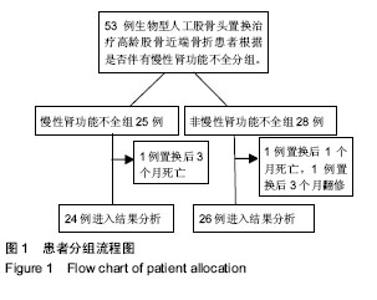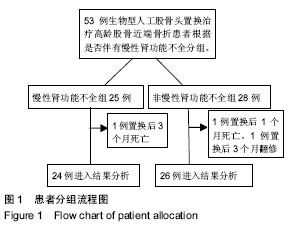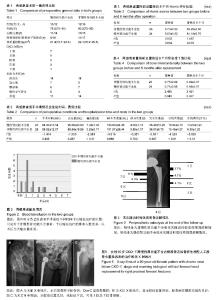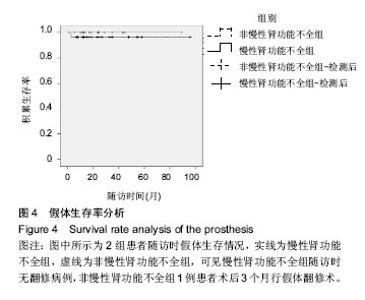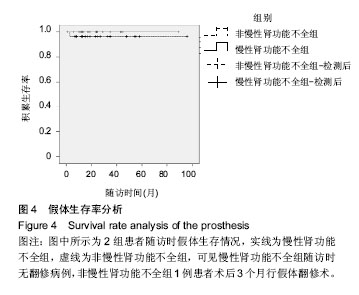| [1] Shukla R, Singh M, Jain RK, et al. Functional outcome of bipolar prosthesis versus total hip replacement in the treatment of femoral neck fracture in elderly Patients. Malays Orthop J. 2017;11(1): 1-5.[2] Sonaje JC, Meena PK, Bansiwal RC, et al. Comparison of functional outcome of bipolar hip arthroplasty and total hip replacement in displaced femoral neck fractures in elderly in a developing country: a 2-year prospective study. Eur J Orthop Surg Traumatol. 2017.[3] Sharma V, Awasthi B, Kumar K, et al. Outcome analysis of hemiarthroplasty vs. total hip replacement in displaced femoral neck fractures in the elderly. J Clin Diagn Res. 2016;10(5): RC11-13.[4] Li Q, Dai B, Yao Y, et al. Chronic kidney dysfunction can increase the risk of deep vein thrombosis after total hip and knee arthroplasty. Biomed Res Int. 2017;2017: 8260487.[5] Miric A, Inacio MC, Namba RS. Can total knee arthroplasty be safely performed in patients with chronic renal disease. Acta Orthop. 2014; 85(1): 71-8.[6] Tan TL, Kheir MM, Tan DD, et al. Chronic kidney disease linearly predicts outcomes after elective total joint arthroplasty. J Arthroplasty. 2016;31(9 Suppl): 175-179.e2.[7] Schmidt AH, Leighton R, Parvizi J, et al. Optimal arthroplasty for femoral neck fractures: is total hip arthroplasty the answer. J Orthop Trauma. 2009;23(6): 428-433.[8] Zhang YL, Chen S, Ai ZS, et al. Osteonecrosis of the femoral head, nonunion and potential risk factors in Pauwels grade-3 femoral neck fractures: A retrospective cohort study. Medicine (Baltimore). 2016; 95(24): e3706.[9] Wang C, Xu GJ, Han Z, et al. Correlation between residual displacement and osteonecrosis of the femoral head following cannulated screw fixation of femoral neck fractures. Medicine (Baltimore). 2015;94(47): e2139.[10] Gruen TA, McNeice GM, Amstutz HC. "Modes of failure" of cemented stem-type femoral components: a radiographic analysis of loosening. Clin Orthop Relat Res. 1979;(141): 17-27.[11] Engh CA, McAuley JP, Sychterz CJ, et al. The accuracy and reproducibility of radiographic assessment of stress-shielding. A postmortem analysis. J Bone Joint Surg Am. 2000;82-A(10): 1414-1420.[12] Harris WH, McGann WA. Loosening of the femoral component after use of the medullary-plug cementing technique. Follow-up note with a minimum five-year follow-up. J Bone Joint Surg Am. 1986;68(7): 1064-1066.[13] Dorr LD, Absatz M, Gruen TA, et al. Anatomic porous replacement hip arthroplasty: first 100 consecutive cases. Semin Arthroplasty. 1990; 1(1): 77-86.[14] Howell SJ, Sear YM, Yeates D, et al. Risk factors for cardiovascular death after elective surgery under general anaesthesia. Br J Anaesth. 1998;80(1): 14-19.[15] Sunday JM, Guille JT, Torg JS. Complications of joint arthroplasty in patients with end-stage renal disease on hemodialysis. Clin Orthop Relat Res. 2002; (397): 350-355.[16] Nagoya S, Nagao M, Takada J, et al. Efficacy of cementless total hip arthroplasty in patients on long-term hemodialysis. J Arthroplasty. 2005;20(1): 66-71.[17] Li WC, Shih CH, Ueng SW, et al. Uncemented total hip arthroplasty in chronic hemodialysis patients. Acta Orthop. 2010;81(2): 178-182.[18] Rogmark C, Fenstad AM, Leonardsson O, et al. Posterior approach and uncemented stems increases the risk of reoperation after hemiarthroplasties in elderly hip fracture patients. Acta Orthop. 2014; 85(1): 18-25.[19] Wang TI, Hung SH, Su YP, et al. Noncemented total hip arthroplasty for osteonecrosis of the femoral head in elderly patients. Orthopedics. 2013;36(3): e271-275. |
